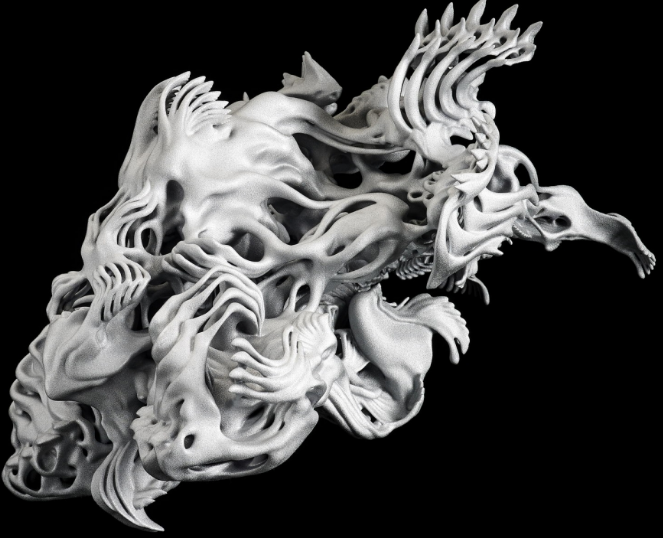One of my favorite things to read and write about is 3D printed art. I’m continually amazed at what people are able to create with a printer and a roll or two of PLA, or a CAD program and some metal powder, or a 3Doodler. The medium is gaining popularity in the art world, but inevitably, as with most new art forms, there are going to be doubters who have to ask, “Sure, it’s nice and all, but is it really art?”
The question of what “art” is has been around for as long as art has been around. Books have been written about it; insufferably pretentious college students (yes, I was one of them) have sat up until dawn debating it; I imagine even the first cave paintings were met with a raised eyebrow or two. “Yeah, it’s nice-looking, but I don’t know, it doesn’t really capture the essence of the antelope, you know what I mean?” Why is a red square on a white background considered art, when any child with full motor skills could reproduce it? Art – and non-art – is endless fodder for debate, but before I get carried away on my insufferably pretentious college high horse, let me return to the main question: is 3D printed art real art?
This is the question posed by recent pieces in the Toronto Star and the Observer, the latter of which asks “Does 3D printing make art too easy?” In my opinion, no. Sure, 3D printing can be easy, especially with the increasing number of plug-and-play, so-simple-a-child-can-use-it printers on the market. But to create an artistic piece, one needs a lot more than just a 3D printer – just like one needs more than just a camera to be a good photographer.
In fact, photographer Edward Burtynsky described 3D printing to the Star as “photography 3.0,” with 2.0 being digital photography as opposed to film. Digital photography is something that I personally struggled with a little bit when it began to all-but-eliminate traditional film photography just as I was graduating college. I spent hours of my college years learning about manual film photography, about the delicate balance of light exposure and shutter speed and the precise chemical processes in the darkroom, and went through countless rolls of film and sheafs of photographic paper struggling to make all of those elements work together to create a final piece. When digital photography burst onto the scene with its automation and software tools that allowed for mistakes to easily be brushed away, it seemed like a cop-out. If anyone can do it by just pushing a couple of buttons, I thought, how is it still an art form?Once I managed to climb down from that particular insufferably pretentious high horse, though, I realized that art, to me anyway, isn’t about the tool. It’s easy to lament the death of the art of photography when scrolling through page after page of Instagram selfies, but if you know where to look, you can find works of breathtaking beauty or razor-sharp social commentary created with no more than an iPhone. Even the oldest forms of photography were scoffed at by more traditional artists who couldn’t comprehend how creating images with a machine could compare with the skill, talent and effort required in painting. Then people like Ansel Adams showed up, and a lot of those voices quieted down.
It’s the same sort of controversy now, only in 3D. Again, I think that art has a lot less to do with the tool or the medium than with the vision of the artist. You can put two people next to each other with the exact same machine, software, and software skills, and one of them might churn out a derivative trinket while the other creates a museum-worthy piece. Design skills are important, but so is the kind of creative thinking that defines an artist.
“Artists don’t develop technology, they develop ideas,” Brandon Vickerd, director of the digital art lab at York University’s Odette Sculpture Center, told the Star. “The ‘why’ of this is really important. It can do anything, but should it? There’s a lot of hype about this in the commercial sector, but this isn’t about a Star Trek notion of art — push a button, and the machine craps out a sculpture for you. Not at all. We’re asking questions about the nature of the medium — what does it mean to make a printed piece, or make one by hand? What’s the difference?”
It’s not an easy question to answer, but it provides a lot of food for thought. It might be clichéd to say that art is in the eye of the beholder, but it really is true to an extent. I’m of the opinion that anything created by humans can be called art – whether it’s good art or bad art is another matter, and that really does depend on personal opinion in many cases. Meanwhile, why can’t 3D printing be just as legitimate an art form as painting or traditional sculpture? It’s not about the tool, it’s what you do with it, and enough remarkable pieces have been created with 3D printers that I think the medium has earned a well-deserved and respectable place in the art world. What are your thoughts? Discuss further in the 3D Printing and Art forum over at 3DPB.com.
Subscribe to Our Email Newsletter
Stay up-to-date on all the latest news from the 3D printing industry and receive information and offers from third party vendors.
You May Also Like
Shaping Tomorrow’s Manufacturing, Today
The ADDMAN story is one of collaboration and purpose. Our employees work every day to simplify manufacturing processes and help companies bring their innovations to market faster. Founded in 2021,...
3DPOD 238: AM in the Nuclear Industry with Adam Travis, Westinghouse
Adam Travis, Global AM Program Leader at Westinghouse, is lifting the veil of secrecy surrounding 3D printing in the nuclear industry for us in this episode of the 3DPOD. He...
3DPOD 237: 3D Printing in Golf with Ryan Roach, Director of Innovation at Cobra PUMA Golf
In this episode of the 3DPOD, we take a deep dive into 3D printing for golf. Cobra PUMA Golf has gone further than other firms, employing Multi Jet Fusion, binder...
3DPOD 236: AM Materials Science & Applications with Nick Sonnentag, Sunnyday Technologies & Oshkosh Corporation
Nick Sonnentag is a Senior Principal Engineer at Oshkosh, where he contributes to the development of some of the world’s toughest vehicles using additive manufacturing (AM). Drawing on experience from...

































